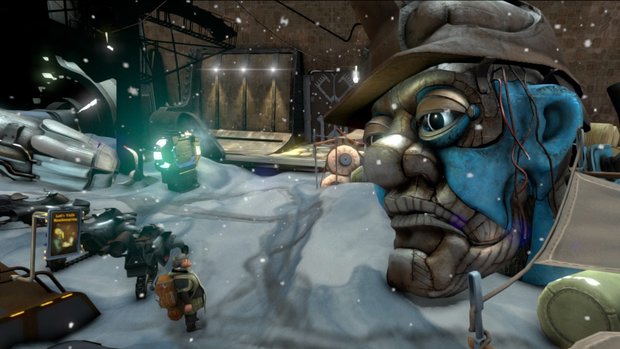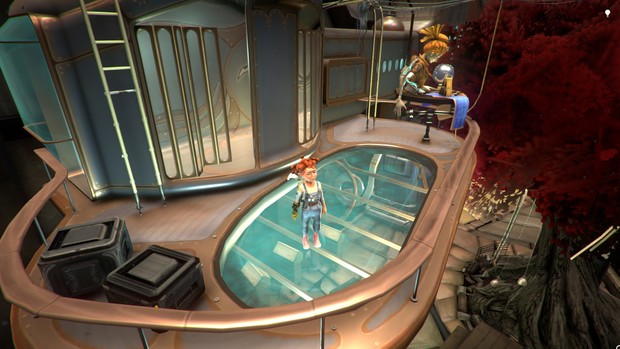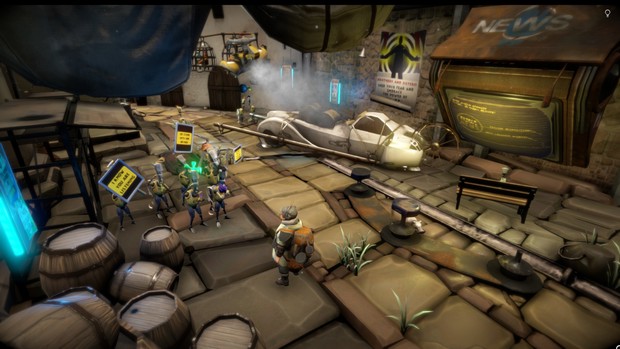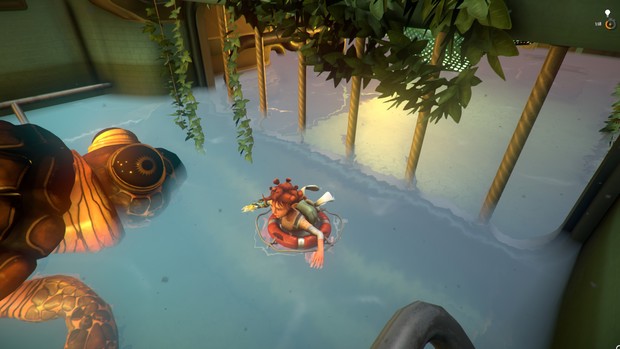KAPIA review

- 0 Comments
Post-apocalyptic adventure feels rushed but plenty of charming, quirky fun remains
There seems to be no shortage of postapocalyptic narratives these days, whether in movies, TV shows, books, games, even the news. Many involve predictably gloomy and potentially devastating outcomes for our near future, but husband-and-wife team 2FOR2’s quirky and fun KAPIA serves up an original and charming futuristic story with a colourful cast in the midst of a more serious backdrop. Its world-building feels a little overstuffed for the relatively short runtime, but some entertaining gameplay helps ensure that it’s plenty of fun while it lasts.
Snow, sandstorms and freezing cold have made the planet uninhabitable, and a worldwide war between the East and the West has been dividing the globe for decades. In order to preserve as many lives as possible, enormous glass domes have been put up over the old cities, where the surviving remnants of civilization have huddled together to carry on as best they can in this broken world.
Our story takes place in one of these domed cities, the titular KAPIA. Here humans and robots live together in … well, not exactly harmony. At one time in history they did, but the isolation and strict rules enforced by the oppressive KAPIA government have created a large social gap between humans and robots, destroying the harmonious relationship they once had. The robots have gone from being equal to humans, to now being their servants, and the people are either joining revolutions, cults or just trying to get by on their own.
In the middle of all this chaos we find our two protagonists, Stefan and his granddaughter Reny. Because of the war, the two of them are the only remaining members of their family, and alongside a bunch of other eccentric characters, they live and work together in KAPIA. Stefan is a burly, rough and rugged guy, whereas Reny is a bold, crafty and adorable little girl who loves her grandpa more than anything.

Stefan was a pilot before the war began, and is now one of few who are able to travel between cities with special vehicles that can endure the harsh environment outside the domes. He has been sent on a mission to another city to deliver and receive a message, but returns to KAPIA with more disconcerting news, after the city he was supposed to visit has disappeared. The message he has retrieved may contain information that could put an end to the war, but before he is able to deliver this directive, he too vanishes without a trace, and Reny makes it her own mission to find him.
You play as both Reny and Stefan in parallel, as they both do their best to possibly save KAPIA and end the war. Stefan involuntarily gets dragged into a plot concerning Onyx, a cult that has emerged in the chaos of the war, and the Eye, an ominous and potentially dangerous presence in the city that somehow seems able to know everything that happens there. Reny, on the other hand, is mostly concerned with finding her grandfather, and on her journey to do so she faces several dangers and challenges. In the dark and dirty sewers she must rescue a giant turtle from becoming turtle soup, who proceeds to tell her about Mother, the once-powerful android leader of KAPIA who may be able to save the city from its evil internal forces.
I couldn’t help but fall in love with Reny’s sassy personality, as she is undoubtedly the heroine of the story with her mechanical hand and heart of gold. Even though she is just a little girl who dreams of one day becoming a space pirate, she displays massive bravery by putting the needs of KAPIA and her grandfather above her own safety and well-being. Another thing that enhanced my adoration for Reny at several points was when she walked in the footsteps of Stefan and encountered the same people and robots her grandfather had stolen from or tricked in some way. Where they describe him as a chubby and short thief (not knowing they’re talking about Stefan), she describes him as tall, strong and insists that he would never do any of the things they say that this “other mystery man” has done, in the naïve and blue-eyed way only a loving child would.

Reny isn’t the only memorable character, though. Indeed, one of the things that makes KAPIA so captivating is its eclectic cast. Throughout their travels, Stefan and Reny meet a whole bunch of strange, quirky figures who either aid them on their journey or obstruct it. For instance, we have Robbi, a robot who lives with the protagonists. In between utilising his babysitting mode and experiencing panic attacks, Robbi is often found contemplating his existence, and is as whacky and delightful as a neurotic robot can be. Another example is NEKO, a mechanical cat who loves nothing more than being in the way and causing trouble. The rest of the motley crew that live with Stefan and Reny are fun too, as are all the mouthy robots we encounter in KAPIA, bitter about the differences between human and robot rights.
If there’s a negative aspect about the characters, it’s that there are just too many to really form a relationship with them, because you only interact with most of them for a very short time. Some characters are introduced and then discarded just as quickly, and I would have liked to see more of these lovingly created figures for longer than just a few minutes.
The puzzles in KAPIA are another thing that really make the game shine. All over town are distribution stations where you can read information and history about KAPIA, but which also feature some fun minigames, such as a Pong-like game and a puzzle where you need to access Robbi’s interface to reconfigure his settings. Other puzzles involve slapping together a sandwich for Reny, serving bar snacks and drinks as Stefan, and making the pressure in some water pipes overload in order to cool down an overheated mechanical dog. I didn’t find the puzzles particularly challenging, but they were really entertaining nonetheless. There are some puzzles that require quick reactions, however, so for people without good reflexes, this might pose a challenge. Even then, most puzzles allow the option to skip them, so it shouldn’t be a big problem.

In terms of interface, KAPIA is a classic point-and-click game through and through, and you have an inventory where you can inspect your items up close. When you start the game, you get to choose whether you want to activate the hint function or not, and if you do, a little lightbulb in the top right corner will tell you what to do next when clicked, with a helpful nudge in the right direction. The hints are only for the main objectives in the game, however, not for how to solve the puzzles themselves.
If you’re like me and play with a mouse and keyboard, you can press Tab to show all the hotspots in the current location, but the game can also be played with a controller, where you achieve the same by pressing the left stick. The mouse mechanics work exactly as you’d expect, but when you play with a controller, any hotspots nearby show up automatically when you’re close, and you interact with them when text appears over the hotspot, such as “Look at Computer.” The game autosaves, so no need to worry about recording your progress, and if you want to revisit a previous part of the game, you can choose to replay a level from the main menu.
KAPIA’s graphics are cartoony and playful, kind of reminding me of the Borderlands aesthetic, just without cel-shading. But the game also gives off some Longest Journey vibes with the city’s whole futuristic style. The town of KAPIA is beautifully designed, with a mix of rundown and hi-tech elements at the same time, giving it the perfect steampunk-ish feeling. On each street corner, you meet robots and eye-shaped face scanners, mechanical animals and neon lights, and Stefan and Reny visit places as low as KAPIA’s sewers and as high as its glass ceiling. Although there are many and long loading scenes, they are filled with beautiful children's drawings that morph into something akin to the in-game graphics, showing different scenes from the game. This is accompanied by a beautiful little snippet of moody music that eases your impatience while waiting for the next scene to load.
In fact, the soundtrack throughout the whole game is great, shifting between dreamy and mellow piano tunes, and bright and upbeat electronic music, perfectly fitting the different circumstances. One thing that isn’t as perfect is the voice acting. Some characters like Reny and Robbi are really well-performed, but others, like Stefan and Mother, are a bit more uneven. They’re not bad, just not that good either. Stefan’s lines feel forced and overly dramatic at times, and although Mother is an android, the delivery of her lines is pretty flat, even for a robot.
One major issue I unfortunately encountered was the camera controls. You play in third person, but as a 3D game the camera isn’t fixed to one point. Instead it just kind of mercilessly swings about as you move around, and the thing you want to click moves with it. Not only is this annoying when you’re trying to click on something while walking and your cursor gets moved away from what you’re trying to click, but the quick sweeping change in camera angles almost made me feel queasy at times. You do get used to it after a while, but it's still irritating. However, this feature wasn’t a problem at all when I tried playing with a controller, and even though I am an old-school mouse and keyboard enthusiast, I must admit that some games play better with a controller, KAPIA surely being one of them.
I was intrigued by the game’s premise and eager to see where it would take me, but for a relatively short game (I played through in roughly five hours) it is way too complicated. You have a world war between The East and The West. Then you have all the inner workings of Dome KAPIA, with its oppressive dictatorial government and revolutionary factions on both sides, not to mention the Onyx cult and the omnipresent Eye. To say it’s all a bit overwhelming would be putting it lightly. I’m sure all these things would have worked fine in a longer game with more room to explore them, but for the short time we are given in KAPIA, it’s simply too much too soon to immerse yourself in the grander scheme of things.
Final Verdict
Despite its unruly camera controls and overwhelming world-building details, KAPIA is a beautiful game that ticks many of the right boxes. It is clearly a labour of love, which shows in so many aspects, particularly the fun characters and amusing puzzles. I can easily forgive the uneven quality of voice acting and dialogue when the soundtrack is as brilliant as it is, and together with the cute and funky graphics, it all amounts to a thoroughly delightful and heartwarming experience.
Hot take
It’s a bit too short for its own good, but when you get used to the wonky camera controls, KAPIA is a beautiful and charming game, serving up a colourful cast and fun puzzles.
Pros
- Quirky, cartoony 3D graphics
- A wonderful bunch of characters, especially the young protagonist Reny
- Beautiful and atmospheric soundtrack
- Fun puzzles and minigames
Cons
- Too many characters and world-building details squeezed into too little game time
- A lot of waiting in long loading scenes
- Uneven quality of voice acting and dialogue
- Quick-cutting angles and lack of camera control when using keyboard/mouse can be difficult to handle
Aurora played her own copy of KAPIA on PC.









0 Comments
Want to join the discussion? Leave a comment as guest, sign in or register.
Leave a comment